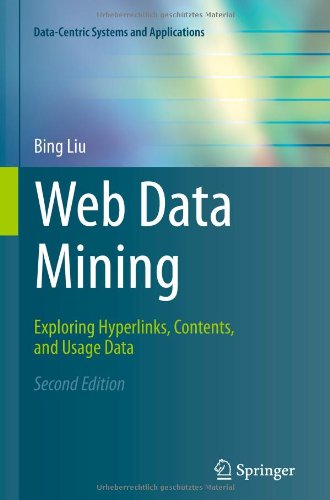Web Data Mining, 2nd Edition: Exploring Hyperlinks, Contents, and Usage Data epub
Par weber william le mardi, octobre 20 2015, 00:05 - Lien permanent
Web Data Mining, 2nd Edition: Exploring Hyperlinks, Contents, and Usage Data . Bing Liu

Web.Data.Mining.2nd.Edition.Exploring.Hyperlinks.Contents.and.Usage.Data..pdf
ISBN: 3642194591,9783642194597 | 643 pages | 17 Mb

Web Data Mining, 2nd Edition: Exploring Hyperlinks, Contents, and Usage Data Bing Liu
Publisher: Springer
Web Data Mining: Exploring Hyperlinks, Contents, and Usage Data (Data-Centric. Web Data Mining encompasses mining knowledge from the web or usage of the web. I will provide a book link at the end of the blog post. Using the HTML Editor; Using the JavaScript Editor. Data Mining 3rd Edition » SCRiPTMAFiA. Web mining aims to discover useful information or knowledge from Web hyperlinks, page contents, and usage logs. Algorithms; Graph-Theoretic Techniques for Web Content Mining; Web Content Mining - Web Mining - UIC - Computer Science Web Content Mining Tutorial given at WWW-2005 and WISE-2005 New Book: Web Data Mining - Exploring Hyperlinks, Contents and Usage Data. [2]; City-planning: Identifying groups of houses according to their house type, value and geographically Web Data Mining Exploring Hyperlinks, Contents, and Usage Data. [2]; Insurance: Identifying groups of motor insurance policy holders with a high average claim cost; identifying frauds. The rapid growth of the Web in the past two decades has made it the largest publicly accessible data source in the world. Clustering is a technique in data mining to find interesting pattern in given data sets that means a large data set is grouped into clusters of smaller sets of similar data. Graph-Theoretic Techniques For Web Content Mining book download Download Graph-Theoretic Techniques For Web Content Mining On 02.16.13,. Content on this page applies to NetBeans IDE 7.3. # Hardcover: 532 pages # Publisher: Springer; 1st ed. Overview of the Application; Programming the Client-Side: Part 1. Ajax interactions can be used to do things such as validate form entries (while the user is entering them) using server-side logic, retrieve detailed data from the server, dynamically update data on a page, and submit partial forms from the page.
The Foucault Effect: Studies in Governmentality pdf